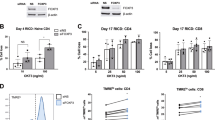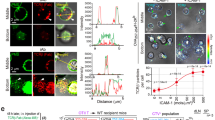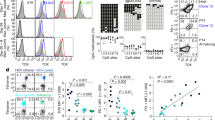Abstract
The survival of T lymphocytes requires sustained, Ca2+ influx–dependent gene expression. The molecular mechanism that governs sustained Ca2+ influx in naive T lymphocytes is unknown. Here we report an essential role for the β3 regulatory subunit of voltage-gated calcium (Cav) channels in the maintenance of naive CD8+ T cells. Deficiency in β3 resulted in a profound survival defect of CD8+ T cells. This defect correlated with depletion of the pore-forming subunit Cav1.4 and attenuation of T cell antigen receptor (TCR)-mediated global Ca2+ entry in CD8+ T cells. Cav1.4 and β3 associated with T cell signaling machinery and Cav1.4 localized in lipid rafts. Our data demonstrate a mechanism by which Ca2+ entry is controlled by a Cav1.4-β3 channel complex in T cells.
This is a preview of subscription content, access via your institution
Access options
Subscribe to this journal
Receive 12 print issues and online access
$209.00 per year
only $17.42 per issue
Buy this article
- Purchase on Springer Link
- Instant access to full article PDF
Prices may be subject to local taxes which are calculated during checkout









Similar content being viewed by others
References
Hogan, P.G., Chen, L., Nardone, J. & Rao, A. Transcriptional regulation by calcium, calcineurin, and NFAT. Genes Dev. 17, 2205–2232 (2003).
Gallo, E.M., Cante-Barrett, K. & Crabtree, G.R. Lymphocyte calcium signaling from membrane to nucleus. Nat. Immunol. 7, 25–32 (2006).
Oukka, M. et al. The transcription factor NFAT4 is involved in the generation and survival of T cells. Immunity 9, 295–304 (1998).
Serfling, E. et al. The role of NF-AT transcription factors in T cell activation and differentiation. Biochim. Biophys. Acta 1498, 1–18 (2000).
Vig, M. et al. CRACM1 multimers form the ion-selective pore of the CRAC channel. Curr. Biol. 16, 2073–2079 (2006).
Prakriya, M. et al. Orai1 is an essential pore subunit of the CRAC channel. Nature 443, 230–233 (2006).
Zhang, S.L. et al. Genome-wide RNAi screen of Ca2+ influx identifies genes that regulate Ca2+ release-activated Ca2+ channel activity. Proc. Natl. Acad. Sci. USA 103, 9357–9362 (2006).
Feske, S. Calcium signalling in lymphocyte activation and disease. Nat. Rev. Immunol. 7, 690–702 (2007).
Lewis, R.S. The molecular choreography of a store-operated calcium channel. Nature 446, 284–287 (2007).
Vig, M. et al. Defective mast cell effector functions in mice lacking the CRACM1 pore subunit of store-operated calcium release-activated calcium channels. Nat. Immunol. 9, 89–96 (2008).
Gwack, Y. et al. Hair loss and defective T- and B-cell function in mice lacking ORAI1. Mol. Cell. Biol. 28, 5209–5222 (2008).
Tareilus, E. et al. A Xenopus oocyte β subunit: evidence for a role in the assembly/expression of voltage-gated calcium channels that is separate from its role as a regulatory subunit. Proc. Natl. Acad. Sci. USA 94, 1703–1708 (1997).
Bichet, D. et al. The I–II loop of the Ca2+ channel α1 subunit contains an endoplasmic reticulum retention signal antagonized by the β subunit. Neuron 25, 177–190 (2000).
Chien, A.J., Gao, T., Perez-Reyes, E. & Hosey, M.M. Membrane targeting of L-type calcium channels. Role of palmitoylation in the subcellular localization of the β2a subunit. J. Biol. Chem. 273, 23590–23597 (1998).
Gao, T., Chien, A.J. & Hosey, M.M. Complexes of the α1C and β subunits generate the necessary signal for membrane targeting of class C L-type calcium channels. J. Biol. Chem. 274, 2137–2144 (1999).
Freise, D. et al. Mutations of calcium channel β subunit genes in mice. Biol. Chem. 380, 897–902 (1999).
Stokes, L., Gordon, J. & Grafton, G. Non-voltage-gated L-type Ca2+ channels in human T cells: pharmacology and molecular characterization of the major alpha pore-forming and auxiliary beta-subunits. J. Biol. Chem. 279, 19566–19573 (2004).
Gomes, B. et al. Lymphocyte calcium signaling involves dihydropyridine-sensitive L-type calcium channels: facts and controversies. Crit. Rev. Immunol. 24, 425–447 (2004).
Badou, A. et al. Critical role for the β regulatory subunits of Cav channels in T lymphocyte function. Proc. Natl. Acad. Sci. USA 103, 15529–15534 (2006).
Kotturi, M.F., Hunt, S.V. & Jefferies, W.A. Roles of CRAC and Cav-like channels in T cells: more than one gatekeeper? Trends Pharmacol. Sci. 27, 360–367 (2006).
Matza, D. et al. A scaffold protein, AHNAK1, is required for calcium signaling during T cell activation. Immunity 28, 64–74 (2008).
Matza, D. et al. Requirement for AHNAK1-mediated calcium signaling during T lymphocyte cytolysis. Proc. Natl. Acad. Sci. USA 106, 9785–9790 (2009).
Zweifach, A. Target-cell contact activates a highly selective capacitative calcium entry pathway in cytotoxic T lymphocytes. J. Cell Biol. 148, 603–614 (2000).
Murakami, M. et al. Pain perception in mice lacking the β3 subunit of voltage-activated calcium channels. J. Biol. Chem. 277, 40342–40351 (2002).
Sprent, J., Cho, J.H., Boyman, O. & Surh, C.D. T cell homeostasis. Immunol. Cell Biol. 86, 312–319 (2008).
Park, J.H. et al. Suppression of IL7Rα transcription by IL-7 and other prosurvival cytokines: a novel mechanism for maximizing IL-7-dependent T cell survival. Immunity 21, 289–302 (2004).
Manicassamy, S. et al. Requirement of calcineurin a for the survival of naive T cells. J. Immunol. 180, 106–112 (2008).
Ueffing, N., Schuster, M., Keil, E., Schulze-Osthoff, K. & Schmitz, I. Up-regulation of c-FLIP short by NFAT contributes to apoptosis resistance of short-term activated T cells. Blood 112, 690–698 (2008).
Entschladen, F. et al. Signal transduction–receptors, mediators, and genes. Sci. Signal 2, mr3 (2009).
Feske, S., Giltnane, J., Dolmetsch, R., Staudt, L.M. & Rao, A. Gene regulation mediated by calcium signals in T lymphocytes. Nat. Immunol. 2, 316–324 (2001).
Lutz, M.B. et al. An advanced culture method for generating large quantities of highly pure dendritic cells from mouse bone marrow. J. Immunol. Methods 223, 77–92 (1999).
Takahashi, S.X., Miriyala, J. & Colecraft, H.M. Membrane-associated guanylate kinase-like properties of β-subunits required for modulation of voltage-dependent Ca2+ channels. Proc. Natl. Acad. Sci. USA 101, 7193–7198 (2004).
He, L.L., Zhang, Y., Chen, Y.H., Yamada, Y. & Yang, J. Functional modularity of the β-subunit of voltage-gated Ca2+ channels. Biophys. J. 93, 834–845 (2007).
Doering, C.J. et al. Modified Cav1.4 expression in the Cacna1fnob2 mouse due to alternative splicing of an ETn inserted in exon 2. PLoS One 3, e2538 (2008).
Hayashi, K. & Altman, A. Filamin A is required for T cell activation mediated by protein kinase C-θ. J. Immunol. 177, 1721–1728 (2006).
Tavano, R. et al. CD28 interaction with filamin-A controls lipid raft accumulation at the T-cell immunological synapse. Nat. Cell Biol. 8, 1270–1276 (2006).
Seminario, M.C. & Bunnell, S.C. Signal initiation in T-cell receptor microclusters. Immunol. Rev. 221, 90–106 (2008).
Markiewicz, M.A., Brown, I. & Gajewski, T.F. Death of peripheral CD8+ T cells in the absence of MHC class I is Fas-dependent and not blocked by Bcl-xL. Eur. J. Immunol. 33, 2917–2926 (2003).
Chuvpilo, S. et al. Autoregulation of NFATc1/A expression facilitates effector T cells to escape from rapid apoptosis. Immunity 16, 881–895 (2002).
Berridge, M.J., Bootman, M.D. & Roderick, H.L. Calcium signalling: dynamics, homeostasis and remodelling. Nat. Rev. Mol. Cell Biol. 4, 517–529 (2003).
Pani, B. & Singh, B.B. Lipid rafts/caveolae as microdomains of calcium signaling. Cell Calcium 45, 625–633 (2009).
Doering, C.J., Hamid, J., Simms, B., McRory, J.E. & Zamponi, G.W. Cav1.4 encodes a calcium channel with low open probability and unitary conductance. Biophys. J. 89, 3042–3048 (2005).
Revy, P., Sospedra, M., Barbour, B. & Trautmann, A. Functional antigen-independent synapses formed between T cells and dendritic cells. Nat. Immunol. 2, 925–931 (2001).
Weissgerber, P. et al. Reduced cardiac L-type Ca2+ current in Cavβ2−/− embryos impairs cardiac development and contraction with secondary defects in vascular maturation. Circ. Res. 99, 749–757 (2006).
McRory, J.E. et al. The CACNA1F gene encodes an L-type calcium channel with unique biophysical properties and tissue distribution. J. Neurosci. 24, 1707–1718 (2004).
Kim, K.B., Lee, J.S. & Ko, Y.G. The isolation of detergent-resistant lipid rafts for two-dimensional electrophoresis. Methods Mol. Biol. 424, 413–422 (2008).
Acknowledgements
We thank E. Eynon for suggestions; F. Manzo for preparing the manuscript; C. Rathinam for critical reading of the manuscript; D. Butkus for thymectomies; T. Taylor for fluorescence-activated cell sorting; and F. Balamuth for advice on lipid raft isolation. Supported by the Arthritis Foundation (M.K.J.), the Fondation pour la Recherche Médicale (A.B.), the Arthritis National Research Foundation (A.B.), Deutsche Forschungsgemeinschaft (V.F. and M.F.), Homburger Forschungsförderungsprogramm (V.F. and M.F.), the Canadian Institutes of Health Research (J.E.M.) and the Howard Hughes Medical Institute (M.K.J., A.B. and R.A.F.).
Author information
Authors and Affiliations
Contributions
M.K.J. conceived of, designed and did all experiments, except Ca2+ imaging, and wrote the paper; A.B. did and analyzed Ca2+ imaging experiments; A.B., M.M., J.E.M., M.F. and V.F. contributed reagents and edited the manuscript and R.A.F. provided overall directions, supervised the project and wrote the paper.
Corresponding author
Supplementary information
Supplementary Text and Figures
Supplementary Figures 1–6 (PDF 720 kb)
Rights and permissions
About this article
Cite this article
Jha, M., Badou, A., Meissner, M. et al. Defective survival of naive CD8+ T lymphocytes in the absence of the β3 regulatory subunit of voltage-gated calcium channels. Nat Immunol 10, 1275–1282 (2009). https://doi.org/10.1038/ni.1793
Received:
Accepted:
Published:
Issue Date:
DOI: https://doi.org/10.1038/ni.1793
This article is cited by
-
Cavβ1 regulates T cell expansion and apoptosis independently of voltage-gated Ca2+ channel function
Nature Communications (2022)
-
GABAergic signaling by cells of the immune system: more the rule than the exception
Cellular and Molecular Life Sciences (2021)
-
Calcium signalling in T cells
Nature Reviews Immunology (2019)
-
Calcium channel auxiliary α2δ and β subunits: trafficking and one step beyond
Nature Reviews Neuroscience (2012)
-
Ion channels and transporters in lymphocyte function and immunity
Nature Reviews Immunology (2012)



